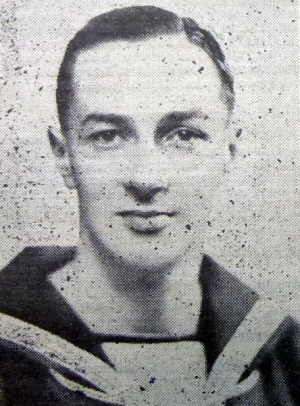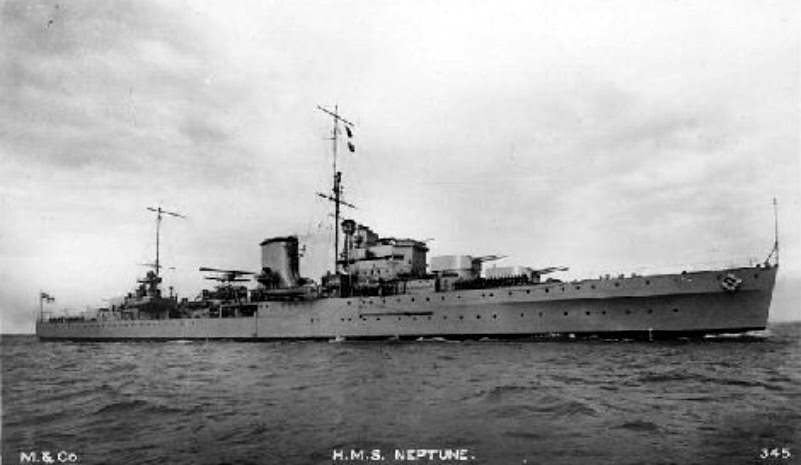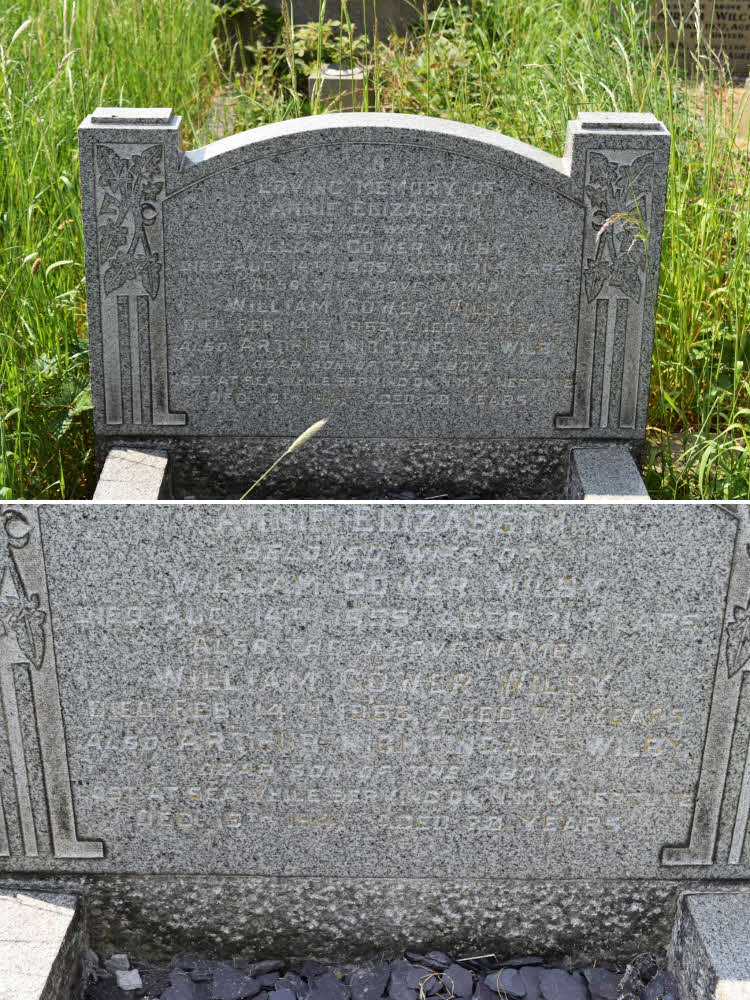
Arthur Nightingale Wilby was born on the 14th September 1913, the son of rag grinder William Gower Wilby (born 1st January 1885) of 1, The Green, Ossett and Annie Elizabeth Nightingale (born 26th July 1884), merino sorter, of 19, Station Road, Ossett, who were married at the Ossett Green Congregational Church on the 1st June 1907.
In 1911, the couple were living in a two-roomed home at 8, Tattersfield Street, Ossett, and, by 1915 the family had moved to South Street, Ossett. In September 1939, William, his wife Annie and their children Arthur and Florence were living at 31, Sowood Avenue, Ossett. William had improved his lot and was a manager at a mungo and shoddy mill, while Arthur was working as a representative of a “carbon” manufacturer. His unmarried sister Florence (born 28th March 1919) was working as an accounts clerk.
At some time, around the start of WW2, Arthur Nightingale left his reps job and joined the Royal Navy where he trained as a telegraphist and wireless operator. It took five months to train a Wireless Telegraphy Operator. They began by learning Morse code and the Navy’s methods of sending and receiving signals. To pass out at the end of the course they had to be able to read at twenty-two words per minute and transmit at ten words per minute. Telegraphists were also trained in coding since there were very few coders at the beginning of the war. Once completing training one became an Ordinary Telegraphist and advanced to Telegraphist and Telegraphist (Trained Operator). Subsequently, Wilby was posted to the British cruiser HMS ‘Neptune’.
More than 75 years ago on the night of the 19th December 1941, there occurred one of the most extensive but least known naval disasters of the Second World War in which Arthur Nightingale Wilby would tragically lose his life. The Cruiser HMS ‘Neptune’ ran into an uncharted minefield in the Mediterranean off Tripoli, and sank with the loss of 764 officers and men. Just one man was rescued by an Italian torpedo boat, after five days in the water.
The “Ossett Observer” had an obituary for Arthur Wilby:1
“Ossett Naval Telegraphist Missing – Mr. and Mrs. W.G. Wilby, 31 Sowood Avenue, Ossett, have received a telegram confirmed by letter dated Saturday last, that their son, Arthur Nightingale Wilby, of the Royal Navy was ‘missing on war service.’ He joined up in July 1940, and was a telegraphist in the wireless section. He was serving in the Middle East.
He was 28 years of age, and lived at home. He received his early education at Southdale Council School, and proceeded to Ossett Grammar School with a county minor scholarship. After being employed for a while by a Wakefield firm of tobacconists, he secured a position as traveller with Caribonum Limited, attached to their Leeds branch.
He attended The Green Congregational Church, and had deputised for the church organist, having also acted as a Sunday School accompanist. He was a member of The Green Institute, and at one time a member of the South Ossett Tennis Club. Whilst employed at Wakefield, he played football with Wakefield Tradesmen’s XI. His father is mill manager to Frank H. Smith, Horbury Bridge.”

Above: HMS ‘Neptune’ a Leander Class cruiser ordered under the 1930 programme from HM Dockyard Devonport on the 2nd March 1931 and laid down on the 24th September that year. She was launched on 31st March 1932 as the 14th Royal Navy ship to carry the name, introduced in 1683 for a 2nd Rate and last used for a 1909 battleship which was sold in 1922. Build was completed on 22nd February 1934. In 1939, she was deployed in the South Atlantic.2
“HMS ‘Neptune’, commanded by Captain Rory O’Conor, was leading ‘Force K’, a Cruiser raiding squadron. Their task was to destroy German and Italian convoys carrying troops and supplies to Libya, in support of Rommel’s army in North Africa. On the afternoon of December 18th the squadron was despatched from Malta to intercept an important enemy convoy bound for Tripoli. The three cruisers of ‘Force K’, the Neptune, Aurora and Penelope, supported by the destroyers Kandahar, Lance, Lively and Havock, were steaming south, in single line ahead on a dark, stormy night when at 01:06 am, the Neptune struck a mine. The Aurora her next astern, hauled out to starboard but only a minute later she too exploded a mine; two minutes later an explosion buffeted Penelope’s port side abreast the bridge. The Neptune going full astern hit another mine, which wrecked her steering gear and propellers and brought her to a standstill. The cruiser force had run into a minefield in a depth of water and at a distance from land which made it utterly unexpected.2
The Aurora contrived to turn and steam out of the field without further catastrophe, followed by the Penelope; Captain Agnew, in command of Aurora considered the situation in all its dire gravity. They were 15 miles from Tripoli and it was nearly dawn. The damage to Aurora had reduced her maximum speed to 10 knots, and his duty was to get her as far from the enemy coast as he could before daylight. The risk of sending another ship into the minefield to tow the Neptune out was hardly justified but the need to save life made it imperative.
The destroyers Kandahar and Lively then entered the minefield in an attempt to reach the Neptune and tow her out. Captain Nicholl was also cautiously edging the Penelope towards her when at 03:18 the Kandahar struck a mine. Captain O’Conor of the Neptune flashed a warning : “Keep away”. At 04:03 she struck a fourth mine which exploded amidships. This was more than her hull could take; she slowly turned over and sank.
The one Neptune survivor, Able Seaman Norman Walton, spent 18 months in Italian prisoner of war camps before being released in 1943.”
 Arthur Nightingale Wilby of 31 Sowood Avenue Ossett “died on or since 19 December 1941 on war service”. Administration of his estate was granted at Wakefield on 12th April 1942 to William Gower Wilby, mill manager. Effects £189 1s 10d. William Gower Wilby of 31, Sowood Avenue, Ossett, survived his son and he died on the 14th February 1963 at The General Hospital, Wakefield when probate was granted to George Wilby, Chief Draughtsman and Florence Mabel Ford (wife of Claude William Ford). Effects £2281 16s.
Arthur Nightingale Wilby of 31 Sowood Avenue Ossett “died on or since 19 December 1941 on war service”. Administration of his estate was granted at Wakefield on 12th April 1942 to William Gower Wilby, mill manager. Effects £189 1s 10d. William Gower Wilby of 31, Sowood Avenue, Ossett, survived his son and he died on the 14th February 1963 at The General Hospital, Wakefield when probate was granted to George Wilby, Chief Draughtsman and Florence Mabel Ford (wife of Claude William Ford). Effects £2281 16s.
Royal Navy Telegraphist Arthur N. Wilby, died on the 19th December 1941, aged 28 years and is remembered on Panel Reference 46.1 on the Chatham Naval Memorial. After the First World War, an appropriate way had to be found of commemorating those members of the Royal Navy who had no known grave, the majority of deaths having occurred at sea where no permanent memorial could be provided.
An Admiralty committee recommended that the three manning ports in Great Britain – Chatham, Plymouth and Portsmouth – should each have an identical memorial of unmistakable naval form, an obelisk, which would serve as a leading mark for shipping. The memorials were designed by Sir Robert Lorimer, who had already carried out a considerable amount of work for the Commission, with sculpture by Henry Poole. The Chatham Naval Memorial was unveiled by the Prince of Wales (the future King Edward VIII) on 26 April 1924.
After the Second World War it was decided that the naval memorials should be extended to provide space for commemorating the naval dead without graves of that war, but since the three sites were dissimilar, a different architectural treatment was required for each. The architect for the Second World War extension at Chatham was Sir Edward Maufe (who also designed the Air Forces memorial at Runnymede) and the additional sculpture was by Charles Wheeler and William McMillan. The Extension was unveiled by the Duke of Edinburgh on 15 October 1952.

Above: The Wilby grave at St. John’s Methodist Chapel showing the memorial to Arthur Nightingale Wilby, son of William Gower Wilby. Picture courtesy of Lisa Jennings.
Chatham Naval Memorial commemorates 8,517 sailors of the First World War and 10,098 of the Second World War.3
References:
1. “Ossett Observer”, Saturday, 3rd January 1942.